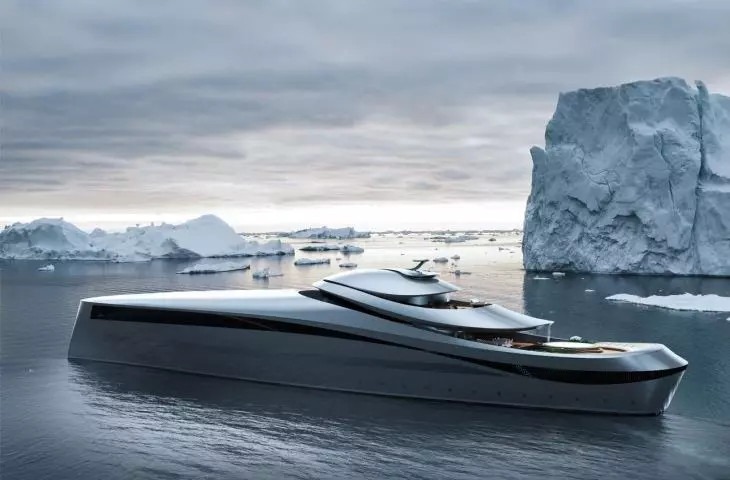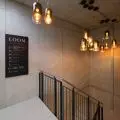{tag:studenci} a graduate in architecture from the Gdańsk University of Technology is involved in yacht design at one of the Tri-City shipyards. Also his master's degree was on this subject. Inspired by the classic form of the Lobster Boat and the blue color and wing movement phases of the Morpho Blue butterfly, he designed the luxury charter yacht Butterfly.
The presented project entitled. "Passenger yachts as an element of architectural design. Design of a motor yacht", made under the direction of Dr. Elżbieta Marczak in the Department of Urban Architecture and Waterfront Spaces. The work received an honorable mention in the SARP O. Wybrzeże Diploma of the Year competition and was nominated for the Zbyszek Zawistowski 2023 Award.
The yacht's profile is characterized by a slender planking line sloping toward the stern
© Paweł Pankowiak
In the age of developing technology, there is an increasing demand for high-end luxury goods including those provided by the shipbuilding industry. The sense of independence and the opportunity to explore the world provided by vessels makes the design and production of yachts and ships play an increasingly important role in the realm of architecture, argues Paweł Pankowiak.
A yacht is the answer to luxury goods
© Paweł Pankowiak
luxury charter yacht
The Butterfly project, an 84-meter-long private charter yacht for long-distance expeditions to both warm and cool climate zones, is a response to this demand. The yacht is designed for 18 passengers and 15 crew members. Reaching a constant speed of 14 knots, it has the ability, to sail up to five thousand nautical miles.
The yacht's profile is characterized by a slender planking line that slopes toward the stern, a sharply sloping bow and a gently raised stern. The architecture is shaped by interpenetrating surfaces that emphasize the division of floors.
yacht axonometry and inspiration
© Paweł Pankowiak
This is what the author says about the design inspiration:
The form of the yacht is the result of a study I conducted of hand-drawn conceptual drawings, keeping in mind economy and minimalism in the creation of the body while maintaining functional assumptions. In my search for ideas, I reached out to two intertwining fields: history and nature, namely the classic Lobster Boat, used in the past century to catch lobsters, and the fascinating world of living organisms, one of the most beautiful species of butterflies Morpho menelaus. These inspirations made it possible to identify the common denominators of transience, beauty and transformation.
The design work was preceded by a study of drawings
© Paweł Pankowiak
passenger area
The functional layout of the yacht is divided into two strategic zones: passenger and service, which, intertwining and complementing each other, constitute one efficient system.
The passenger (hotel) zone was designed to allow potential users to perform active and passive activities—as much at the time of travel during the day as at night, the architect adds.
longitudinal and cross sections
© Paweł Pankowiak
There are large recreational spaces that intermingle with the outdoor and indoor zones. The author used extensive glazing, view openings and mobile balconies on the sides allowing contact with nature and giving the opportunity to enjoy the surrounding views.
Main deck—is a partially covered, representative area with a centrally located swimming pool
© Paweł Pankowiak
The most important space is the main deck—this is a partially covered, representative area with a centrally located swimming pool, as well as lounge areas and arranged greenery, which seamlessly redirects users to the interior, where the lobby is located. Entrance to the vessel is via an axially located stern gate and side entrances in the central part of the yacht with additional stairs hidden in the hull plating.
The yacht is divided into passenger and service areas
© Paweł Pankowiak
Closer to the yacht's bow, the architect designed six suites with private bathrooms, including one adapted for people with limited mobility. Distinctive open sun decks, along with lounge and pool areas, connect to the lobby, lounge, library and dining room, linking the outdoor area aft and the indoor area amidships.
Lounge areas and greenery on the main deck
© Paweł Pankowiak
crew area
The crew area is divided into the service area of the hotel area with social facilities and the yacht service area, which includes the wheelhouse, engine room and other technical rooms necessary for the proper operation of the yacht. At the bow of the vessel, the author designed a garage with two spaces for pontoons and technical rooms. The lower deck connects the space intended for passengers—the water sports and SPA area, with the service area, which includes the main garage and crew rooms.
Butterfly yacht profile
© Paweł Pankowiak
The energy needed to power the yacht and the hybrid drive is produced using a specially programmed parametric array of panels armed with perovskite photovoltaic cells.
















































